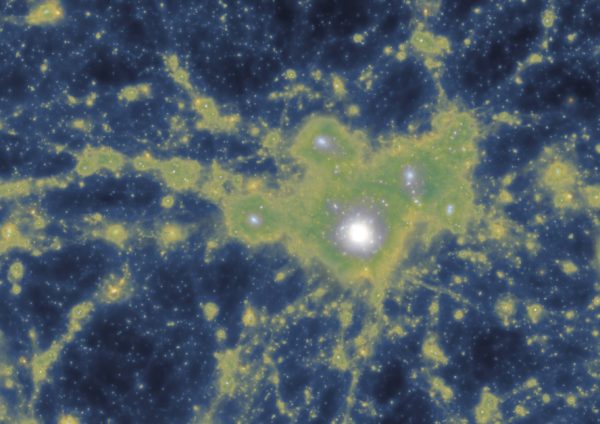Modelling shows big galaxies get bigger by merging with smaller ones
TORONTO, Friday, April 24, 2020 – Galaxies grow large by eating their smaller neighbours, finds an international research team, including York University.
Exactly how massive galaxies attain their size is poorly understood, not least because they swell over billions of years. But now through a combination of observation and modelling, researchers, including the Faculty of Science’s Leo Alcorn, a York Science Fellow, have found a clue.

Distribution of dark matter density overlayed with the gas density. This image cleanly shows the gas channels connecting the central galaxy with its neighbours. Credit: Gupta et al/ASTRO 3D
The research team, led by Post-Doctoral Researcher Anshu Gupta from Australia’s ARC Centre of Excellence for All Sky Astrophysics in 3 Dimensions (ASTRO 3D), included scientists from Australian, the United States, Canada, Mexico, Belgium and the Netherlands. They ran their modelling on a specially designed set of simulations known as IllustrisTNG.
In the paper, MOSEL Survey: Tracking the Growth of Massive Galaxies at 2 < z < 4 Using Kinematics and the IllustrisTNG Simulation, published in The Astrophysical Journal, the scientists combine data from an Australian project called the Multi-Object Spectroscopic Emission Line (MOSEL) survey with a cosmological modelling program running on some of the world’s largest supercomputers to glimpse the forces that create these ancient galactic monsters.
By analysing how gases within galaxies move it is possible to discover the proportion of stars made internally – and the proportion effectively cannibalised from elsewhere.
“We found that distant, massive galaxies, about 10 billion light years away from us, have more chaotic or random internal motions,” says Alcorn. “This is likely because these galaxies have merged with smaller galaxies, producing gravitational disruptions to the orbits of stars and gas. This matter is incorporated into the massive galaxies, growing the galaxy in mass and size”
Because light takes time to travel through the universe, galaxies further away from the Milky Way are seen at an earlier point in their existence. The team found that observation and modelling of these very distant galaxies revealed much less variation in their internal movements.
“As these huge galaxies gain more stars, they are able to gravitationally attract and merge with more surrounding small galaxies. Over billions of years, these old, massive galaxies grow increasingly chaotic, disordered, and large, constantly feeding on nearby neighbours,” says Alcorn.
This is a multi-year, international project that aims to build a series of large cosmological models of how galaxies form. The program is so big that it has to run simultaneously on several of the world’s most powerful supercomputers.
-30-
York University champions new ways of thinking that drive teaching and research excellence. Our students receive the education they need to create big ideas that make an impact on the world. Meaningful and sometimes unexpected careers result from cross-disciplinary programming, innovative course design and diverse experiential learning opportunities. York students and graduates push limits, achieve goals and find solutions to the world’s most pressing social challenges, empowered by a strong community that opens minds. York U is an internationally recognized research university – our 11 faculties and 25 research centres have partnerships with 200+ leading universities worldwide. Located in Toronto, York is the third largest university in Canada, with a strong community of 53,000 students, 7,000 faculty and administrative staff, and more than 300,000 alumni. York U's fully bilingual Glendon Campus is home to Southern Ontario's Centre of Excellence for French Language and Bilingual Postsecondary Education.
Media Contact:
Sandra McLean, York University Media Relations, 416-272-6317, sandramc@yorku.ca

